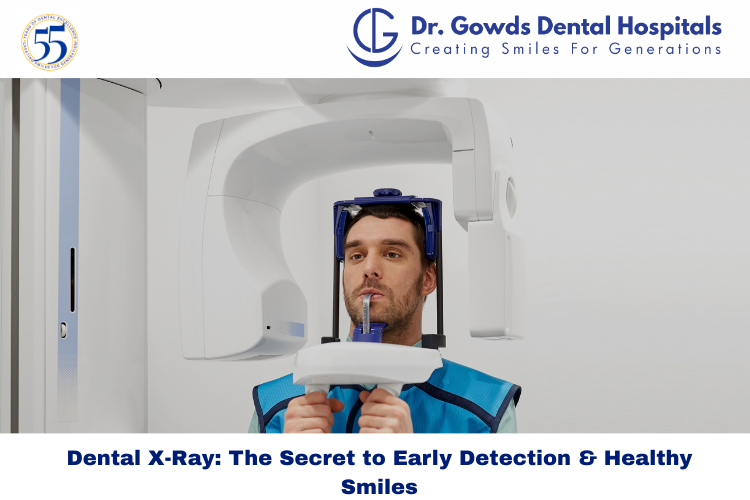Schedule Appointment




You may feel that your teeth are fine – no pain, no visual damage – but oral health often hides your warning signals deep under the surface. This is why dental X-rays are one of the most powerful devices in modern dentistry. These quick, painless scans give your dentist a complete picture of your oral health, including the invisible fields during the regular examination.
At Dr. Gowds Dental Hospital, we use digital dental X-rays as a diagnostic cornerstone. They help us detect issues early, plan precisely, and deliver long-term results.
A dental X-ray (or radiograph) uses controlled levels of radiation to capture images of your teeth, bones, and surrounding tissues. It reveals:
While you may not see these issues in the mirror or feel symptoms right away, your dentist can catch them early — often before they become painful or expensive to treat.
Every mouth is different, and so are the X-rays we use. Here’s a closer look at the most common types:
Show the upper and lower teeth in a single view, often used to detect cavities between teeth and check the fit of restorations.
Focus on one or two complete teeth, from crown to root, to detect problems at the root or bone structure.
Capture a full view of your mouth in a single image. Perfect for spotting impacted teeth, jaw issues, or planning treatments like braces or implants.
Show the floor or roof of the mouth and are especially useful in tracking tooth development in children.
These tools allow our dentists to build a complete and precise picture of your dental health.
There isn’t a rule that applies to everyone. The time of your dental X-ray is determined by:
In general:
We tailor this strategy at Dr. Gowds Dental Hospital, constantly striking a balance between minimal exposure and diagnostic value.
Modern digital dental X-rays use up to 90% less radiation than traditional film X-rays. The risk is extremely low — and far outweighed by the benefits of early diagnosis.
Additionally, we use:
Even for children and pregnant women, dental X-rays are considered safe when taken with proper precautions.
If you’re avoiding X-rays because your teeth “feel fine,” consider this: most serious dental problems — like bone infections, cysts, or early decay — don’t cause symptoms until damage is advanced.
Skipping your dental X-ray could delay diagnosis and lead to:
Routine X-rays are about prevention, not just reaction. They help us act early, which means better outcomes for you.
At Dr. Gowds Dental Hospital, we don’t take X-rays for the sake of it. We take them when it matters — and we use advanced technology to ensure:
Whether it’s part of your routine check-up or needed to guide a root canal, crown, or implant — X-rays help us treat you with confidence and precision.
A dental X-ray is more than just a picture — it’s the first step toward lasting oral health. It helps us diagnose problems early, personalize your care, and give you a healthier, more confident smile.
When was your last dental X-ray? If it’s been more than a year — or if you’re experiencing any dental concerns — book a consultation at Dr. Gowds Dental Hospital, Hyderabad, today.
Our Branches
Many dental problems, like cavities between teeth or bone infections, don’t show symptoms until they’re advanced. X-rays allow early detection so your dentist can prevent small issues from becoming major concerns.
Yes. Digital dental X-rays use very low radiation levels — up to 90% less than traditional film. With lead aprons and proper shielding, they are considered safe even for children and expectant mothers when necessary.
It depends on your age, dental history, and risk factors. Generally, adults with good oral health may need bitewing X-rays every 12–24 months, while children or patients undergoing treatment may require them more frequently.
X-rays help uncover hidden issues like cavities between teeth, tooth root infections, impacted wisdom teeth, bone loss from gum disease, abscesses, and jaw development problems — all of which are hard to detect through visual exams alone.
We use advanced digital X-ray technology that ensures minimal radiation, instant results, and precise treatment planning. Our approach is smart, safe, and only used when truly needed to support your long-term oral health.